All pet food manufacturers want their products to be eaten.
All pet food manufacturers thus need to design palatable pet foods.
But how to know whether a product is appetizing?
How to know whether Max will run to his bowl to eat his kibbles? Or whether fish is more attractive to Kitty than a mouse?
And what about pet owners? Should their opinion be part of the equation?
From acceptance measurement to enjoyment assessment, discover methods to uncover what pets crave.

Expert or in-home panel?
The first step to obtaining relevant answers about food preferences of cats and dogs is to choose the panelists.
Pet food palatability tests can be run either with expert pets in dedicated facilities or in-home with owners’ pets.
Expert panels are made up of pets trained to take part in sensory evaluations. They live in catteries and kennels. Tests are carried out by professional animal technicians and ethologists under controlled conditions and environment.
In-home panels are constituted of family-owned pets, selected according to criteria like age, sex and breed. These tasters are naïve and do not have any training.
Both panels have pros and cons, depending on the desired information:
– Thanks to controlled conditions, expert panels are often more accurate and give more consistent answers.
– In-home panels are generally less discriminant, but they can bring interesting information on pet owners’ perception of their pets’ satisfaction, in real conditions. They also make it easy to get owner opinions on organoleptic characteristics of products.
To counterbalance potential lack of precision, in-home panels rely on a high number of animals—80 pets minimum—while 40 pets are generally enough to get accurate answers from expert panels.

The one-bowl test, a simple way to evaluate acceptability
In a one-bowl test, also called monadic test, one food is presented to the animal and the quantity consumed, which indicates the acceptance level of the diet, is measured.
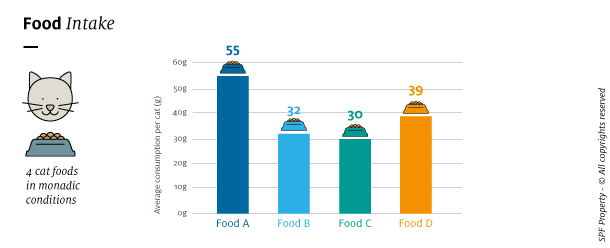
This simple method is regularly used in expert panels. It is also the main one used in panels at home.
The one-bowl test allows ranking of several diets according to their acceptability levels, using an appropriate experimental plan (sequential monadic design).
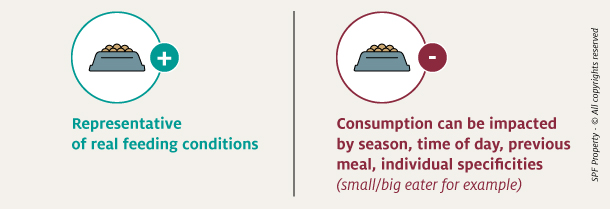

The two-bowl test, a classic to assess preferences
The two-bowl test is the most common method used in expert panels. Also called versus test, it is based on a simultaneous presentation of two foods to pets. It determines whether a preference is expressed by measuring the eaten quantities of each product.
Two main parameters are assessed in a two-bowl test:
• the first choice: the first product tasted is mainly driven by pet food odor and reflects food attractiveness.
• the intake ratio: the amount of each product consumed versus the total amount of food consumed. The greater the intake, the higher the palatability!
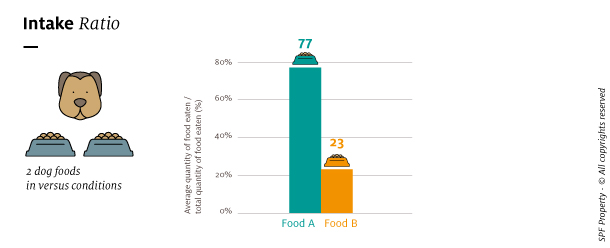
Although the two-bowl test is a paired comparison, it can be used to compare and rank more than two products by setting a specific experimental plan.
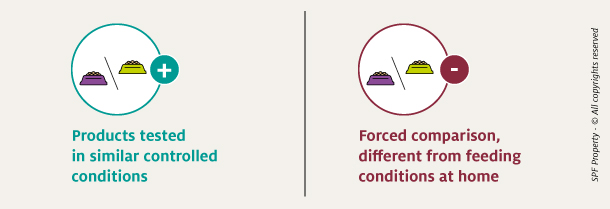

The Liking test, an advanced monadic method that delivers enjoyment insights
The Liking test is a variant of the standard one-bowl method. Conducted in Panelis* expert panels only, it precisely assesses food acceptance but also enjoyment.
In the Liking test, food rations are individually adjusted according to animals’ usual consumption. One diet is presented to pets and various parameters reflecting pets’ feeding enjoyment are measured:
• the % of ration eaten
• the gap between the level of consumption at the test and the reference consumption**
• the % of finished bowls
• the % of refusals
• the consumption speed
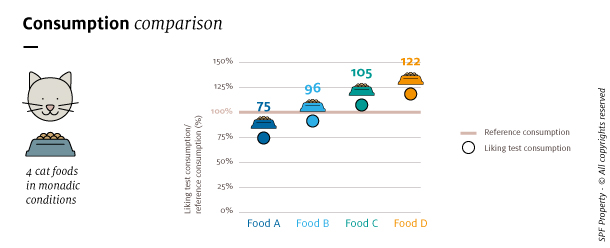
*Panelis is Symrise Pet Food measurement center.
**The reference consumption is based on each animal’s food intake history and the environment natural variations (season, meal of the day, etc.).
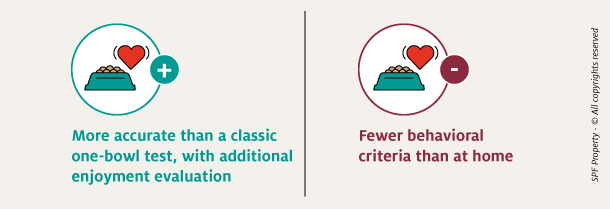

Kinetics, a dynamic method to profile food consumption over time
In addition to the total amount consumed, the kinetics method measures the way food is eaten over time. Conducted in monadic or versus conditions, it brings information on food attractiveness and consumption profile.
The kinetics method is available in cat food expert panels only. During the test, cats have access to their bowl for 16 to 20 h, and more than 10 parameters are monitored:
• % of animals with a feeding event during the first 30 minutes of meal
• average consumption per feeding event
• number of feeding events with no or very low consumption
• total consumption at the end of the test
• …
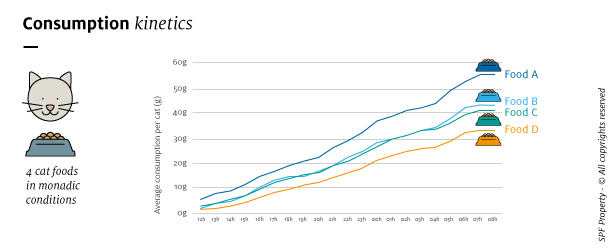
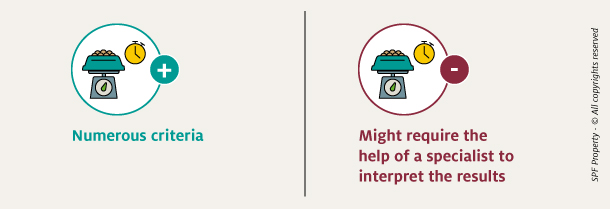

Behavioral observation: pet enjoyment, from the owner side
Beyond food intake, animal body language and facial expressions during the meal have recently been successfully used to assess palatability. They enable assessment of food enjoyment level as perceived by pet parents.
The study of body language is based on the observation of pets’ behaviors by the owner at several moments of the meal.
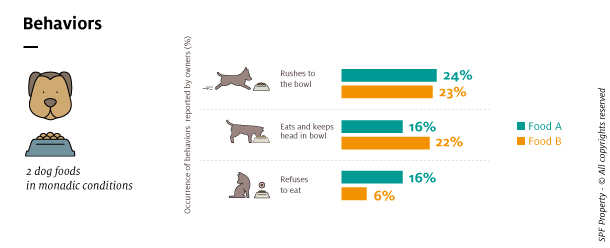
Behaviors sought include actions like the following:
• Run to the bowl
• Hesitates before eating
• Refuses to eat
• Raises head regularly when eating
• Licks nose
• …
Diets with the higher number of positive behaviors are considered more palatable.
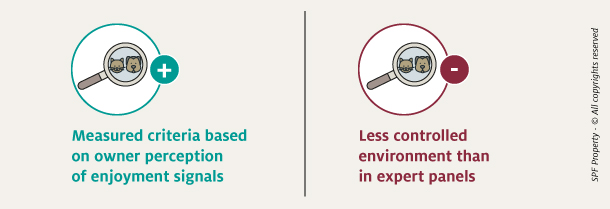

What else?
Less conventional methods can be used to assess the sensory performance of a pet food.
Some protocols are used to study one precise aspect of a product. The false-bottom bowl method, for instance, allows ethologists to specifically observe a dog’s reaction to pet food odors.
Attractiveness can also be estimated through the level of motivation induced by food smell. In this method, animals are asked to solve a complex task to be able to get the food as a reward.

Finally, physiological signals such as body temperature and cardiac parameters can be used as indicators of a dog’s excitement during the meal.
Although innovative and accurate, these approaches are quite different from real feeding conditions of pets, and they require complex animal training. They are more adapted to basic research on palatability than pet food product development.
To sum up, how to choose?
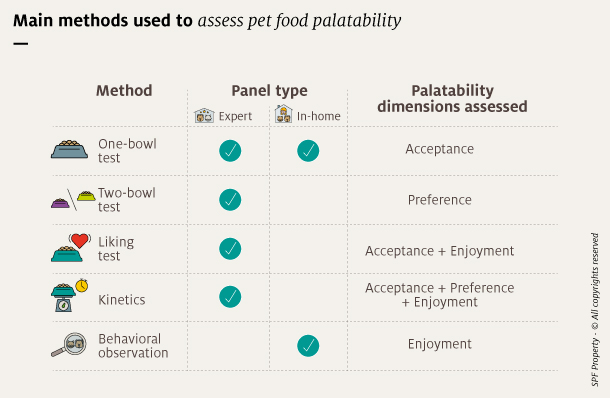
All these protocols provide great opportunities to understand dogs’ and cats’ food preferences and to develop products Max and Kitty will love.
However, this rich portfolio may be considered complex and can even induce confusion.
Which method is the best? Unfortunately, there’s no one-size-fits-all answer. Each method evaluates different aspects of palatability.
The choice of one or even several methods should be made according to the goal you pursue.
Differentiate from competition? Be sure that pet parents will love your pet food too?
To choose the right method, you need to ask the right questions.
To be continued…
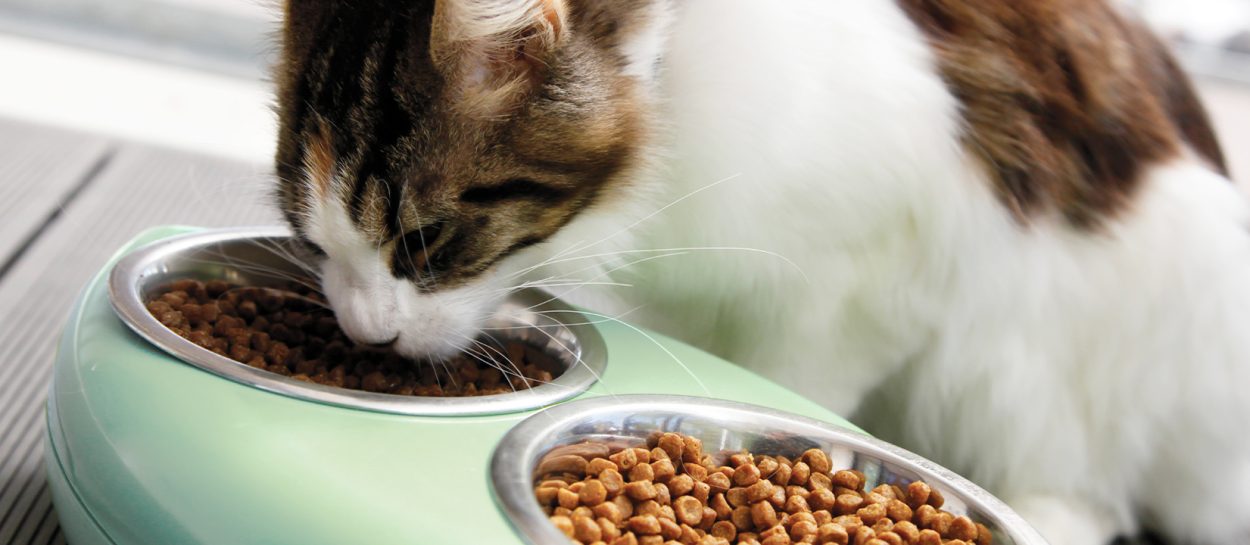

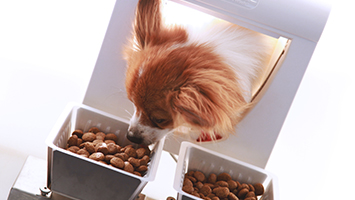
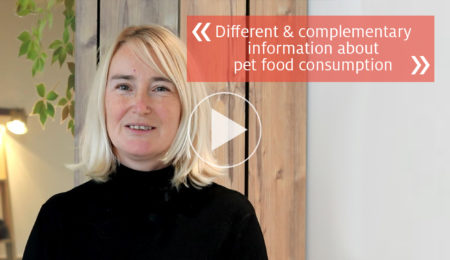
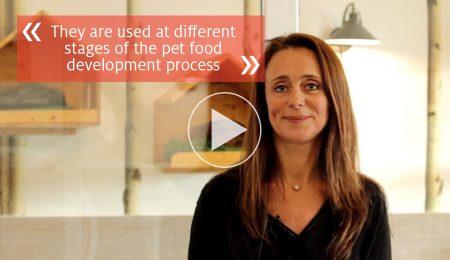
* required fields